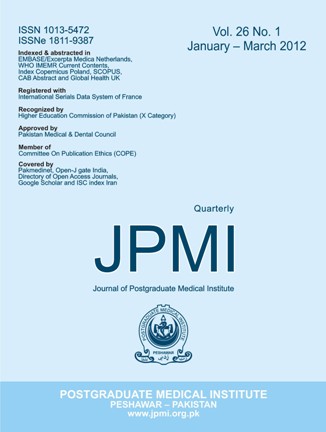ANXIETY AND DEPRESSION IN NURSES WORKING IN GOVERNMENT TERTIARY CARE TEACHING HOSPITALS OF PESHAWAR KHYBER PAKHTUNKHWA AND THEIR RELATIONSHIP WITH JOB STRESS
Main Article Content
Abstract
Objectives: To estimate the prevalence and intensity of anxiety and depression and its relationship with job
stress among the nursing staff.
Methodology: This cross sectional analytical descriptive study was conducted in three teaching hospitals of
Peshawar from 1st August 2006 to 30th November 2006. Convenient sampling was used. The sample
consisted of 700 nurses. Sociodemographic details were collected through a proforma. Self rating
translated Job Stress Questionnaire was administered followed by self rating Urdu version of AKUAD scale
for estimation of job stress and intensity of anxiety and depression. SPSS version 16 was used for
statistics.
Results: The prevalence of anxiety and depression was 100% with mean score of 41±10.70 and job stress
38.96±18.76. The prevelance of mild, moderate,severe and very severe degrees of anxiety and depression
was 55.6%,39.3%,4.6% and 0.6% respectively. There was no significant correlation between total scores
on (AKUADS) and job stress on JSQ (0.836 P≥0.5). Five items of job stress: Inability to satisfy patients
(0.022, P ≤0.5), health hazards (o.oo3, P ≤o.5), dealing violent patients (0.001,P≤0.5),dealing abusive
patients(0.043≤0.5) and shift work(0.027, P ≤0.05) showed statistically negative correlation with severity
of anxiety and depression.
Conclusion: All nurses in our study had anxiety and depression, majority were in mild to moderate
intensity range. Although no significant relationship was observed between anxiety and depression and job
stress as a whole, yet significant negative relationship with some aspects of job stress was found. The
findings reflected a public health issue.
stress among the nursing staff.
Methodology: This cross sectional analytical descriptive study was conducted in three teaching hospitals of
Peshawar from 1st August 2006 to 30th November 2006. Convenient sampling was used. The sample
consisted of 700 nurses. Sociodemographic details were collected through a proforma. Self rating
translated Job Stress Questionnaire was administered followed by self rating Urdu version of AKUAD scale
for estimation of job stress and intensity of anxiety and depression. SPSS version 16 was used for
statistics.
Results: The prevalence of anxiety and depression was 100% with mean score of 41±10.70 and job stress
38.96±18.76. The prevelance of mild, moderate,severe and very severe degrees of anxiety and depression
was 55.6%,39.3%,4.6% and 0.6% respectively. There was no significant correlation between total scores
on (AKUADS) and job stress on JSQ (0.836 P≥0.5). Five items of job stress: Inability to satisfy patients
(0.022, P ≤0.5), health hazards (o.oo3, P ≤o.5), dealing violent patients (0.001,P≤0.5),dealing abusive
patients(0.043≤0.5) and shift work(0.027, P ≤0.05) showed statistically negative correlation with severity
of anxiety and depression.
Conclusion: All nurses in our study had anxiety and depression, majority were in mild to moderate
intensity range. Although no significant relationship was observed between anxiety and depression and job
stress as a whole, yet significant negative relationship with some aspects of job stress was found. The
findings reflected a public health issue.
Article Details
How to Cite
1.
Khan SA, Farooq S, Bano A. ANXIETY AND DEPRESSION IN NURSES WORKING IN GOVERNMENT TERTIARY CARE TEACHING HOSPITALS OF PESHAWAR KHYBER PAKHTUNKHWA AND THEIR RELATIONSHIP WITH JOB STRESS. J Postgrad Med Inst [Internet]. 2011 Dec. 29 [cited 2025 Dec. 13];26(1). Available from: https://jpmi.org.pk/index.php/jpmi/article/view/1213
Issue
Section
Original Article
Work published in JPMI is licensed under a
Creative Commons Attribution-NonCommercial 2.0 Generic License.
Authors are permitted and encouraged to post their work online (e.g., in institutional repositories or on their website) prior to and during the submission process, as it can lead to productive exchanges, as well as earlier and greater citation of published work.


